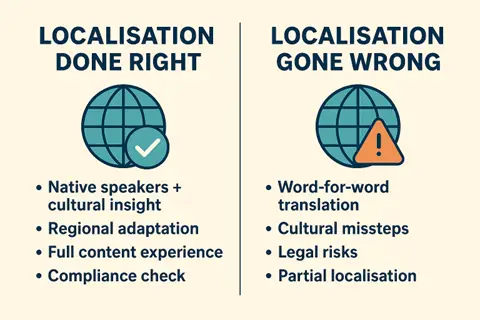Expanding into new markets is exciting, but it’s also a huge risk if you get it wrong. Especially in the B2B world, where the stakes are high and the relationships are long. One of the biggest mistakes businesses make during expansion is not localising their content properly.
So, what does “localisation” mean? In simple terms, it’s changing your message to match the local slang, language, and customs of your market. It’s more than just translation; it’s about making your message feel native to your target audience.
In this article, we’ll explore the most common localisation errors, and how strong editorial processes can prevent them.
What Is Localisation, Really?
Translation vs Localisation
First off, it’s important to understand that translation is not localisation. Translation is simply converting text from one language to another. Localisation, on the other hand, is about adjusting your message so it makes sense in the new market, both culturally and linguistically.
For example, a phrase that’s catchy in the U.S. might be meaningless—or even offensive—in India. You’re not just converting words; you’re adapting ideas, jokes, idioms, product names, and even visuals.
Localisation Lessons from the Big Guys: McDonald’s and KFC
How Editorial Teams Shape Local Relevance
Let’s look at how global franchises manage localisation. When companies like McDonald’s and KFC expand into new regions, they don’t just replicate their US menu. They do deep research into local food habits. That’s why you’ll see a McAloo Tikki Burger in India or a Paneer Zinger from KFC—items that don’t exist in the Western world but are tailored for Indian palates.
This isn’t just about making people happy. Editorial teams and localisation experts ensure messaging, menus, and promotions avoid cultural missteps. If these companies do not localise their menu, they risk business failure—or worse, legal and PR issues. For example, not understanding the importance of vegetarianism or the cultural sensitivity around beef in India can seriously backfire.
6 Localisation Mistakes to Avoid in B2B Content
Localisation errors aren’t limited to fast-food chains. In the B2B world, they show up in documents, product manuals, software, websites, and marketing content—and they can damage your reputation, alienate customers, and even trigger legal trouble.
Here’s where editorial teams play a critical role in catching and preventing errors before they reach your audience.
1. Poor Translation Quality
Why It’s a Big Problem
Low-quality translations are one of the biggest culprits behind failed localisation efforts. They can cause misunderstandings, damage your brand’s credibility, and lead to reduced user engagement. Imagine sending out a client proposal where half the terms don’t make sense, or worse, come across as rude.
In some industries, poor translation isn’t just embarrassing—it can be dangerous. Think of technical manuals for medical devices or industrial machinery. If something is mistranslated, the consequences could be serious.
How Editorial Teams Can Fix This
Investing in professional translation and editorial services help mitigate these issues.
- Use native speakers who understand the local context and industry jargon.
- Don’t rely solely on tools like Google Translate. It’s fine for basic phrases, but it won’t catch the nuances or the “flavour” of the local language.
- Editing and proofreading should be non-negotiable. Always have a second set of eyes (preferably another native speaker) go over your translated content before it goes live.
2. Ignoring Regional Differences
One Country, Many Cultures
A lot of people treat countries as if they’re a single market. But that’s far from the truth—especially in a country like India. India alone has 122 major languages, hundreds of dialects, and drastically different cultural practices between states.
For example:
- In some Indian states like Kerala or Goa, beef consumption is legal and part of the local cuisine.
- In others like Uttar Pradesh or Rajasthan, it’s not only frowned upon but completely banned.
Now imagine you’re a food tech company expanding into India with a beef-based product and one-size-fits-all marketing. You’ll not only alienate large portions of your audience—you might also face legal or religious backlash.
Tailoring Content by Region
Even if you’re localising for one country, go deeper:
- Understand regional dialects and expressions.
- Adjust visuals, symbols, and references.
- Even product packaging and colour choices can have different connotations.
Do the research. Ideally, collaborate with people who live in those regions or at least understand them thoroughly. Editors can adapt phrasing, examples, and references while checking for regional sensitivities in terminology and visuals.
3. Overlooking Legal Requirements
Why Legal Compliance Matters
Each country—and often, each region—has its own set of legal and regulatory requirements. Ignoring these can lead to fines, lawsuits, or getting banned from the market entirely.
In the B2B world, this could be anything from:
- Data privacy laws (like GDPR in Europe or DPDP in India)
- Product labelling rules
- Advertising restrictions
- Language mandates for public-facing material
What to Do
Stay on top of local laws before launching. That includes:
- Collaborating with local legal advisors
- Ensuring your translated content is not just correct, but compliant
- Including local disclaimers, terms and conditions, and privacy policies
Even if your content is flawless, if it doesn’t meet legal standards, you’re setting yourself up for trouble. Legal editors ensure compliance by reviewing disclaimers, contracts, and public-facing documents for region-specific rules.
4. Translating Just One or Two Things
Partial Localisation = Incomplete Experience
One common mistake is to translate just a landing page or an app screen and stop there. Then when users dig deeper, the rest of the experience is still in English (or another base language).
This breaks user trust. It feels half-baked. Imagine trying to use an app where the buttons are in your language, but the help articles or support chats are not.
The Fix: Localise the Whole Experience
True localisation means:
- Website
- Mobile app
- Onboarding emails
- Push notifications
- SMS messages
- Customer support scripts
- FAQ pages
- Legal documents
Yes, it’s a lot. But users notice the difference when the whole journey feels seamless in their language. Content editors help plan full-document localisation so the entire customer journey—FAQs, support scripts, product manuals—feels consistent.
5. No Clear Localisation Strategy
You Need a Game Plan
Jumping into localisation without a strategy is like building a house without a blueprint. You’ll probably waste time, overspend, and still end up with something fragile.
A localisation strategy should cover:
- Which languages you’re prioritising
- Which content should be translated first
- Who your stakeholders are
- What success looks like (KPIs, engagement, conversions, etc.)
Start Small, But Smart
You don’t need to localise everything from day one. But have a plan for gradual rollout:
- Begin with your core markets
- Focus on high-impact content like sales material or onboarding flows
- Learn from the feedback and scale from there
Editorial project managers create workflows, assign reviewers, and define style guides that ensure consistency across languages.
6. Ignoring Technology
Doing Everything Manually Slows You Down
Some teams still manage localisation using spreadsheets, copy-pasting content back and forth between translators and developers. This is not only slow—it’s a recipe for errors.
Manual localisation:
- Breaks easily
- Causes version mismatches
- Wastes time on back-and-forth communication
Embrace Localisation Tools
There are plenty of platforms out there (like Lokalise, Crowdin, Phrase, etc.) designed to help teams:
- Keep all translations in sync
- Work with multiple languages simultaneously
- Automate updates and deployment
- Integrate with your content management system (CMS), apps, and websites
Using the right tech can save time, reduce costs, and help you avoid costly mistakes. Editorial teams working with localisation platforms (like Lokalise or Phrase) help maintain consistency in terminology, style, and version control.

Source: Inkorporated
Final Thoughts: Localisation Is Not Optional in 2025
In today’s globalised world, localisation isn’t a luxury—it’s a necessity. Whether you’re a SaaS company, a fintech brand, or an enterprise services provider, your audience expects content that feels native to them.
Getting it wrong can damage your reputation. Getting it right can help you:
- Build trust
- Increase engagement
- Improve conversion rates
- Stay legally compliant
- Scale globally with confidence
So, if you’re expanding into new markets, treat localisation as a core part of your go-to-market strategy—not an afterthought. And remember: editorial teams aren’t just polishers—they’re safeguards against costly localisation errors.
Need help with editing, proofreading and presentations? You know where to find us.

